Design a Java application that will read a file containing d
Design a Java application that will read a file containing data related to the US. Crime statistics from 1994-2013. The description of the file is shown below. The application should provide statistical results on the data including:
a. Population growth in percentages from each consecutive year (e.g. 1994-1995 calculation is ((262803276 - 260327021)/260327021)*100 = 0.9512%, 1995-1996 would be ((265228572 - 262803276)/262803276)*100 = 0.9229%)
b. Years where the maximum and minimum Murder rates occurred.
c. Years where the maximum and minimum Robbery rates occurred.
d. Total percentage change in Motor Vehicle Theft between the years 1998 and 2012.
e. Two (2) additional crime statistics results you add to enhance the application functionality.
The following are some design criteria and specific requirements that need to be addressed:
a. Use command line arguments to send in the name of the US Crime Data file.
b. You are not allowed to modify the Crime.csv Statistic data file included in this assignment.
c. Use arrays and Java classes to store the data. (Hint: You can and should create a USCrimeClass to store the fields. You can also have an Array of US Crime Objects.)
d. Your design should include multiple classes to separate the functionality of the application.
e. You should create separate methods for each of the required functionality. (e.g. getMaxMurderYear() will return the Year where the Murder rate was highest. )
f. A user-friendly and well-organized menu should be used for users to select which data to return. A sample menu is shown in run example. You are free to enhance your design and you should add additional menu items and functionality.
g. The menu system should be displayed at the command prompt, and continue to redisplay after results are returned or until Q is selected. If a user enters an invalid menu item, the system should redisplay the menu with a prompt asking them to enter a valid menu selection
h. The application should keep track of the elapsed time (in seconds) between once the application starts and when the user quits the program. After the program is exited, the application should provide a prompt thanking the user for trying the US Crime Statistics program and providing the total time elapsed.
Here is sample run:
java TestUSCrime Crime.csv
********** Welcome to the US Crime Statistical Application **************************
Enter the number of the question you want answered. Enter ‘Q’ to quit the program :
1. What were the percentages in population growth for each consecutive year from 1994 – 2013?
2. What year was the Murder rate the highest?
3. What year was the Murder rate the lowest?
4. What year was the Robbery rate the highest?
5. What year was the Robbery rate the lowest?
6. What was the total percentage change in Motor Vehicle Theft between 1998 and 2012?
7. What was [enter your first unique statistic here]?
8. What was [enter your second unique statistic here]?
Q. Quit the program
Enter your selection: 2
The Murder rate was highest in 1994
Enter the number of the question you want answered. Enter ‘Q’ to quit the program :
1. What were the percentages in population growth for each consecutive year from 1994 – 2013?
2. What year was the Murder rate the highest?
3. What year was the Murder rate the lowest?
4. What year was the Robbery rate the highest?
5. What year was the Robbery rate the lowest?
6. What was the total percentage change in Motor Vehicle Theft between 1998 and 2012?
7. What was [enter your first unique statistic here]?
8. What was [enter your second unique statistic here]?
Q. Quit the program
Enter your selection: 5
The Robbery rate was lowest in 2013
Enter the number of the question you want answered. Enter ‘Q’ to quit the program :
1. What were the percentages in population growth for each consecutive year from 1994 – 2013?
2. What year was the Murder rate the highest?
3. What year was the Murder rate the lowest?
4. What year was the Robbery rate the highest?
5. What year was the Robbery rate the lowest?
6. What was the total percentage change in Motor Vehicle Theft between 1998 and 2012?
7. What was [enter your first unique statistic here]?
8. What was [enter your second unique statistic here]?
Q. Quit the program
Enter your selection: Q
Thank you for trying the US Crimes Statistics Program.
Elapsed time in seconds was: 32
Link to csv file: https://docs.google.com/spreadsheets/d/1W0ibvNu_VmXI6mZ9KGV8kP9KVsIZyueevb19jX3krYY/edit?usp=sharing
Solution
Here is the code and output for the question.
USCrime.java
import java.util.Comparator;
import java.util.Scanner;
public class USCrime implements Comparable<USCrime> {
private static final int EXPECTED_NO_OF_COLUMNS = 20;
private int year = 0;
private long populationCount = 0L;
private long violentCrimeCount = 0L;
private float violentCrimeRate = 0.0F;
private long murderCount = 0L;
private float murderRate = 0.0F;
private long rapeCount = 0L;
private float rapeRate = 0.0F;
private long robberyCount = 0L;
private float robberyRate = 0.0F;
private long aggravatedAssaultCount = 0L;
private float aggravatedAssaultRate = 0.0F;
private long propertyCrimeCount = 0L;
private float propertyCrimeRate = 0.0F;
private long burglaryCount = 0L;
private float burglaryRate = 0.0F;
private long larcenyCount = 0L;
private float larcenyRate = 0.0F;
private long motorVehicleTheftCount = 0L;
private float motorVehicleTheftRate = 0.0F;
public static final Comparator<USCrime> murderRateComparator = new Comparator<USCrime>() {
@Override
public int compare(USCrime record1, USCrime record2) {
double diff = record1.getMurderRate() - record2.getMurderRate();
if(diff < 0)
return -1;
else if(diff == 0)
return 0;
else
return 1;
}
};
public static final Comparator<USCrime> robberyRateComparator = new Comparator<USCrime>() {
@Override
public int compare(USCrime record1, USCrime record2) {
double diff = record1.getRobberyRate() - record2.getRobberyRate();
if(diff < 0)
return -1;
else if(diff == 0)
return 0;
else
return 1;
}
};
public static final Comparator<USCrime> burglaryRateComparator = new Comparator<USCrime>() {
@Override
public int compare(USCrime record1, USCrime record2) {
double diff = record1.getBurglaryRate() - record2.getBurglaryRate();
if(diff < 0)
return -1;
else if(diff == 0)
return 0;
else
return 1;
}
};
public static final Comparator<USCrime> larcencyRateComparator = new Comparator<USCrime>() {
@Override
public int compare(USCrime record1, USCrime record2) {
double diff = record1.getLarcenyRate() - record2.getLarcenyRate();
if(diff < 0)
return -1;
else if(diff == 0)
return 0;
else
return 1;
}
};
public USCrime() {
}
public boolean loadRecord(final String csvLine) {
boolean retFlag = true;
Scanner scanner = null;
try {
scanner = new Scanner(csvLine);
scanner.useDelimiter(\",\");
year = scanner.nextInt();
populationCount = scanner.nextLong();
violentCrimeCount = scanner.nextLong();
violentCrimeRate = scanner.nextFloat();
murderCount = scanner.nextLong();
murderRate = scanner.nextFloat();
rapeCount = scanner.nextLong();
rapeRate = scanner.nextFloat();
robberyCount = scanner.nextLong();
robberyRate = scanner.nextFloat();
aggravatedAssaultCount = scanner.nextLong();
aggravatedAssaultRate = scanner.nextFloat();
propertyCrimeCount = scanner.nextLong();
propertyCrimeRate = scanner.nextFloat();
burglaryCount = scanner.nextLong();
burglaryRate = scanner.nextFloat();
larcenyCount = scanner.nextLong();
larcenyRate = scanner.nextFloat();
motorVehicleTheftCount = scanner.nextLong();
motorVehicleTheftRate = scanner.nextFloat();
} catch(Exception ex) {
//Skip the record that\'s invalid
retFlag = false;
}
finally {
if(scanner != null) {
try {
scanner.close();
} catch (Exception ex) {
//NO OP - safe to ignore
}
}
}
return retFlag;
}
public int getYear() {
return year;
}
public long getPopulationCount() {
return populationCount;
}
public long getViolentCrimeCount() {
return violentCrimeCount;
}
public float getViolentCrimeRate() {
return violentCrimeRate;
}
public long getMurderCount() {
return murderCount;
}
public float getMurderRate() {
return murderRate;
}
public long getRapeCount() {
return rapeCount;
}
public float getRapeRate() {
return rapeRate;
}
public long getRobberyCount() {
return robberyCount;
}
public float getRobberyRate() {
return robberyRate;
}
public long getAggravatedAssaultCount() {
return aggravatedAssaultCount;
}
public float getAggravatedAssaultRate() {
return aggravatedAssaultRate;
}
public long getPropertyCrime() {
return propertyCrimeCount;
}
public float getPropertyCrimeRate() {
return propertyCrimeRate;
}
public long getBurglaryCount() {
return burglaryCount;
}
public float getBurglaryRate() {
return burglaryRate;
}
public long getLarcenyCount() {
return larcenyCount;
}
public float getLarcenyRate() {
return larcenyRate;
}
public long getMotorVehicleTheftCount() {
return motorVehicleTheftCount;
}
public float getMotorVehicleTheftRate() {
return motorVehicleTheftRate;
}
@Override
public int compareTo(USCrime record) {
return getYear() - record.getYear();
}
public void setYear(final int year) {
this.year = year;
}
}
USCrimeAnalyser.java
import java.io.BufferedReader;
import java.io.File;
import java.io.FileReader;
import java.util.ArrayList;
import java.util.Collections;
import java.util.Comparator;
import java.util.List;
import java.util.Scanner;
public class USCrimeAnalyser {
private final ArrayList<USCrime> crimeDataList = new ArrayList<USCrime>();
public USCrimeAnalyser() {
}
//Step 1: Read the crime data file
//Step 2: Analyse and provide interactive reporting on the results.
public void processFile(final String crimeDataFile) {
long startTimeInMs = System.currentTimeMillis();
try {
readCrimeDataFile(crimeDataFile);
reportResults();
} catch (Exception ex) {
System.err.println(\"Error: [\" + ex.getMessage() + \"]\");
}
long endTimeInMs = System.currentTimeMillis();
System.out.println(\"Thank you for trying the US Crimes Statistics Program. Elapsed time was: [\" + (endTimeInMs-startTimeInMs)/1000 + \"]s\");
}
//Step:1 Read the US Crime data contents from the file and load them into a list
private void readCrimeDataFile(final String crimeDataFilePath) throws Exception {
final File crimeDataFile = new File(crimeDataFilePath);
if(!crimeDataFile.exists() || !crimeDataFile.canRead()) {
throw new Exception(\"Failed to read the file. Check if the crime data file [\" + crimeDataFilePath + \"] exists and if the permissions are valid.\");
}
BufferedReader bufFileReader = null;
try {
bufFileReader = new BufferedReader( new FileReader(crimeDataFile));
String crimeIncidentLine = null;
while((crimeIncidentLine = bufFileReader.readLine()) != null) {
final USCrime usCrimeIncident = new USCrime();
if(usCrimeIncident.loadRecord(crimeIncidentLine)) {
crimeDataList.add(usCrimeIncident);
}
}
} catch (Exception ex) {
throw new Exception(\"Failed to read file contents. Message: [\" + ex.getMessage() + \"]\");
} finally {
if(bufFileReader != null) {
try {
bufFileReader.close();
} catch (Exception ex) {
//NO OP //Safe to ignore
}
}
}
}
//Step 2: Report the analysis
private void reportResults() throws Exception {
if(crimeDataList == null || crimeDataList.size() == 0) {
throw new Exception(\"No data to analyse\");
}
//Sort the crimeData list by year
Collections.sort(crimeDataList);
Scanner scanner = null;
try {
scanner = new Scanner(System.in);
String userInput = null;
boolean showMenu = true;
while(showMenu) {
System.out.println(\"\ \");
System.out.println(\"============= [Welcome to the US Crime Statistical Application] =============\");
System.out.println(\"[1]. What were the percentages in population growth for each consecutive year from 1994 – 2013?\");
System.out.println(\"[2]. What year was the Murder rate the highest?\");
System.out.println(\"[3]. What year was the Murder rate the lowest?\");
System.out.println(\"[4]. What year was the Robbery rate the highest?\");
System.out.println(\"[5]. What year was the Robbery rate the lowest?\");
System.out.println(\"[6]. What was the total percentage change in Motor Vehicle Theft between 1998 and 2012?\");
System.out.println(\"[7]. What year was the Burglary rate the highest?\");
System.out.println(\"[8]. What year was the Larcency rate the lowest?\");
System.out.print(\"\ Enter your selection [1-8] or [Q to quit]: \");
userInput = scanner.nextLine();
switch(userInput.trim()) {
case \"1\":
calculate1994To2013PopulationGrowthStatistic();
break;
case \"2\":
calculateHighestMurderRateYear();
break;
case \"3\":
calculateLowestMurderRateYear();
break;
case \"4\":
calculateHighestRobberyRateYear();
break;
case \"5\":
calculateLowestRobberyRateYear();
break;
case \"6\":
calculate1998To2012MotorVehicleTheftRateChangeStatistic();
break;
case \"7\":
calculateHighestBurglaryRateYear();
break;
case \"8\":
calculateLowestLarcencyRateYear();
break;
case \"Q\":
case \"q\":
showMenu = false;
break;
default:
System.err.println(\"Error: Invalid option. Enter [1-8] or [Q to quit]\");
}
}
} finally {
if(scanner != null) {
try {
scanner.close();
} catch (Exception e) {
//NO OP - safe to ignore
}
}
}
}
private static USCrime getCrimeRecordForYear(final List<USCrime> crimeDataList, final int year) {
final USCrime yearCrimeRecordProxy = new USCrime();
yearCrimeRecordProxy.setYear(year);
int foundPosition = Collections.binarySearch(crimeDataList, yearCrimeRecordProxy);
if(foundPosition >= 0) {
return crimeDataList.get(foundPosition);
}
return null;
}
private void calculate1994To2013PopulationGrowthStatistic() {
for(int year = 1994; year < 2013; year++) {
final USCrime yearCrimeRecord = getCrimeRecordForYear(crimeDataList, year);
final USCrime nextYearCrimeRecord = getCrimeRecordForYear(crimeDataList, year+1);
if(yearCrimeRecord != null && nextYearCrimeRecord != null) {
double yoyPopulationPercent = ((nextYearCrimeRecord.getPopulationCount() - yearCrimeRecord.getPopulationCount()) * 100.0 /yearCrimeRecord.getPopulationCount());
System.out.println(\"Year \" + year + \" - \" + (year+1) + \" = \" + String.format(\"%.4f\", yoyPopulationPercent) + \"%\");
}
}
}
private void calculateHighestMurderRateYear() {
final USCrime highestMurderRateCrime = Collections.max(crimeDataList, USCrime.murderRateComparator);
if(highestMurderRateCrime != null) {
System.out.println(\"The Murder rate was highest in [\" + highestMurderRateCrime.getYear() + \"] with [\" + highestMurderRateCrime.getMurderRate() + \"]\");
} else {
System.out.println(\"Unable to retrieve the highest murder rate with the given data set\");
}
}
private void calculateLowestMurderRateYear() {
final USCrime lowestMurderRateCrime = Collections.min(crimeDataList, USCrime.murderRateComparator);
if(lowestMurderRateCrime != null) {
System.out.println(\"The Murder rate was lowest in [\" + lowestMurderRateCrime.getYear() + \"] with [\" + lowestMurderRateCrime.getMurderRate() + \"]\");
} else {
System.out.println(\"Unable to retrieve the lowest murder rate with the given data set\");
}
}
private void calculateHighestRobberyRateYear() {
final USCrime highestRobberyRateCrime = Collections.max(crimeDataList, USCrime.robberyRateComparator);
if(highestRobberyRateCrime != null) {
System.out.println(\"The Robbery rate was highest in [\" + highestRobberyRateCrime.getYear() + \"] with [\" + highestRobberyRateCrime.getRobberyRate()+ \"]\");
} else {
System.out.println(\"Unable to retrieve the highest robbery rate with the given data set\");
}
}
private void calculateLowestRobberyRateYear() {
final USCrime lowestRobberyRateCrime = Collections.min(crimeDataList, USCrime.robberyRateComparator);
if(lowestRobberyRateCrime != null) {
System.out.println(\"The Robbery rate was lowest in [\" + lowestRobberyRateCrime.getYear() + \"] with [\" + lowestRobberyRateCrime.getRobberyRate() + \"]\");
} else {
System.out.println(\"Unable to retrieve the lowest robbery rate with the given data set\");
}
}
private void calculate1998To2012MotorVehicleTheftRateChangeStatistic() {
double total = 0;
for(int year = 1998; year < 2011; year++) {
final USCrime yearCrimeRecord = getCrimeRecordForYear(crimeDataList, year);
final USCrime nextYearCrimeRecord = getCrimeRecordForYear(crimeDataList, year+1);
if(yearCrimeRecord != null && nextYearCrimeRecord != null) {
double changePercent = ((nextYearCrimeRecord.getMotorVehicleTheftCount()- yearCrimeRecord.getMotorVehicleTheftCount()) * 100.0 /yearCrimeRecord.getMotorVehicleTheftCount());
total += changePercent;
}
}
System.out.printf(\"Year 1998-2012 = %.2f%% %n\", total);
}
private void calculateHighestBurglaryRateYear() {
final USCrime highestBurglaryRateCrime = Collections.max(crimeDataList, USCrime.burglaryRateComparator);
if(highestBurglaryRateCrime != null) {
System.out.println(\"The Burglary rate was highest in [\" + highestBurglaryRateCrime.getYear() + \"] with [\" + highestBurglaryRateCrime.getBurglaryRate() + \"]\");
} else {
System.out.println(\"Unable to retrieve the highest burglary rate with the given data set\");
}
}
private void calculateLowestLarcencyRateYear() {
final USCrime lowestLarcencyRateCrime = Collections.min(crimeDataList, USCrime.larcencyRateComparator);
if(lowestLarcencyRateCrime != null) {
System.out.println(\"The Larcency rate was lowest in [\" + lowestLarcencyRateCrime.getYear() + \"] with [\" + lowestLarcencyRateCrime.getLarcenyRate() + \"]\");
} else {
System.out.println(\"Unable to retrieve the lowest larcency rate with the given data set\");
}
}
//Entry point
public static void main(String[] args) {
String crimeDataFilePath = null;
if(args.length > 0) {
crimeDataFilePath = args[0].trim();
} else {
System.err.println(\"Usage: java USCrimeAnalyser [Path to crime data file in CSV format]\");
}
USCrimeAnalyser crimeAnalyser = new USCrimeAnalyser();
crimeAnalyser.processFile(crimeDataFilePath);
}
}
output
============= [Welcome to the US Crime Statistical Application] =============
[1]. What were the percentages in population growth for each consecutive year from 1994 – 2013?
[2]. What year was the Murder rate the highest?
[3]. What year was the Murder rate the lowest?
[4]. What year was the Robbery rate the highest?
[5]. What year was the Robbery rate the lowest?
[6]. What was the total percentage change in Motor Vehicle Theft between 1998 and 2012?
[7]. What year was the Burglary rate the highest?
[8]. What year was the Larcency rate the lowest?
Enter your selection [1-8] or [Q to quit]: 1
Year 1994 - 1995 = 0.9512%
Year 1995 - 1996 = 0.9229%
Year 1996 - 1997 = 0.9633%
Year 1997 - 1998 = 0.9203%
Year 1998 - 1999 = 0.9039%
Year 1999 - 2000 = 3.2018%
Year 2000 - 2001 = 1.3843%
Year 2001 - 2002 = 0.9310%
Year 2002 - 2003 = 0.9775%
Year 2003 - 2004 = 0.9862%
Year 2004 - 2005 = 0.9706%
Year 2005 - 2006 = 0.9752%
Year 2006 - 2007 = 0.7424%
Year 2007 - 2008 = 0.8085%
Year 2008 - 2009 = 0.9692%
Year 2009 - 2010 = 0.7569%
Year 2010 - 2011 = 0.7298%
Year 2011 - 2012 = 0.7336%
Year 2012 - 2013 = 0.7185%
============= [Welcome to the US Crime Statistical Application] =============
[1]. What were the percentages in population growth for each consecutive year from 1994 – 2013?
[2]. What year was the Murder rate the highest?
[3]. What year was the Murder rate the lowest?
[4]. What year was the Robbery rate the highest?
[5]. What year was the Robbery rate the lowest?
[6]. What was the total percentage change in Motor Vehicle Theft between 1998 and 2012?
[7]. What year was the Burglary rate the highest?
[8]. What year was the Larcency rate the lowest?
Enter your selection [1-8] or [Q to quit]: 2
The Murder rate was highest in [1994] with [9.0]
============= [Welcome to the US Crime Statistical Application] =============
[1]. What were the percentages in population growth for each consecutive year from 1994 – 2013?
[2]. What year was the Murder rate the highest?
[3]. What year was the Murder rate the lowest?
[4]. What year was the Robbery rate the highest?
[5]. What year was the Robbery rate the lowest?
[6]. What was the total percentage change in Motor Vehicle Theft between 1998 and 2012?
[7]. What year was the Burglary rate the highest?
[8]. What year was the Larcency rate the lowest?
Enter your selection [1-8] or [Q to quit]: 3
The Murder rate was lowest in [2013] with [4.5]
============= [Welcome to the US Crime Statistical Application] =============
[1]. What were the percentages in population growth for each consecutive year from 1994 – 2013?
[2]. What year was the Murder rate the highest?
[3]. What year was the Murder rate the lowest?
[4]. What year was the Robbery rate the highest?
[5]. What year was the Robbery rate the lowest?
[6]. What was the total percentage change in Motor Vehicle Theft between 1998 and 2012?
[7]. What year was the Burglary rate the highest?
[8]. What year was the Larcency rate the lowest?
Enter your selection [1-8] or [Q to quit]: 4
The Robbery rate was highest in [1994] with [237.8]
============= [Welcome to the US Crime Statistical Application] =============
[1]. What were the percentages in population growth for each consecutive year from 1994 – 2013?
[2]. What year was the Murder rate the highest?
[3]. What year was the Murder rate the lowest?
[4]. What year was the Robbery rate the highest?
[5]. What year was the Robbery rate the lowest?
[6]. What was the total percentage change in Motor Vehicle Theft between 1998 and 2012?
[7]. What year was the Burglary rate the highest?
[8]. What year was the Larcency rate the lowest?
Enter your selection [1-8] or [Q to quit]: 5
The Robbery rate was lowest in [2013] with [109.1]
============= [Welcome to the US Crime Statistical Application] =============
[1]. What were the percentages in population growth for each consecutive year from 1994 – 2013?
[2]. What year was the Murder rate the highest?
[3]. What year was the Murder rate the lowest?
[4]. What year was the Robbery rate the highest?
[5]. What year was the Robbery rate the lowest?
[6]. What was the total percentage change in Motor Vehicle Theft between 1998 and 2012?
[7]. What year was the Burglary rate the highest?
[8]. What year was the Larcency rate the lowest?
Enter your selection [1-8] or [Q to quit]: 6
Year 1998-2012 = -51.33%
============= [Welcome to the US Crime Statistical Application] =============
[1]. What were the percentages in population growth for each consecutive year from 1994 – 2013?
[2]. What year was the Murder rate the highest?
[3]. What year was the Murder rate the lowest?
[4]. What year was the Robbery rate the highest?
[5]. What year was the Robbery rate the lowest?
[6]. What was the total percentage change in Motor Vehicle Theft between 1998 and 2012?
[7]. What year was the Burglary rate the highest?
[8]. What year was the Larcency rate the lowest?
Enter your selection [1-8] or [Q to quit]: 7
The Burglary rate was highest in [1994] with [1042.1]
============= [Welcome to the US Crime Statistical Application] =============
[1]. What were the percentages in population growth for each consecutive year from 1994 – 2013?
[2]. What year was the Murder rate the highest?
[3]. What year was the Murder rate the lowest?
[4]. What year was the Robbery rate the highest?
[5]. What year was the Robbery rate the lowest?
[6]. What was the total percentage change in Motor Vehicle Theft between 1998 and 2012?
[7]. What year was the Burglary rate the highest?
[8]. What year was the Larcency rate the lowest?
Enter your selection [1-8] or [Q to quit]: 8
The Larcency rate was lowest in [2013] with [1899.4]
============= [Welcome to the US Crime Statistical Application] =============
[1]. What were the percentages in population growth for each consecutive year from 1994 – 2013?
[2]. What year was the Murder rate the highest?
[3]. What year was the Murder rate the lowest?
[4]. What year was the Robbery rate the highest?
[5]. What year was the Robbery rate the lowest?
[6]. What was the total percentage change in Motor Vehicle Theft between 1998 and 2012?
[7]. What year was the Burglary rate the highest?
[8]. What year was the Larcency rate the lowest?
Enter your selection [1-8] or [Q to quit]: q
Thank you for trying the US Crimes Statistics Program. Elapsed time was: [17]s
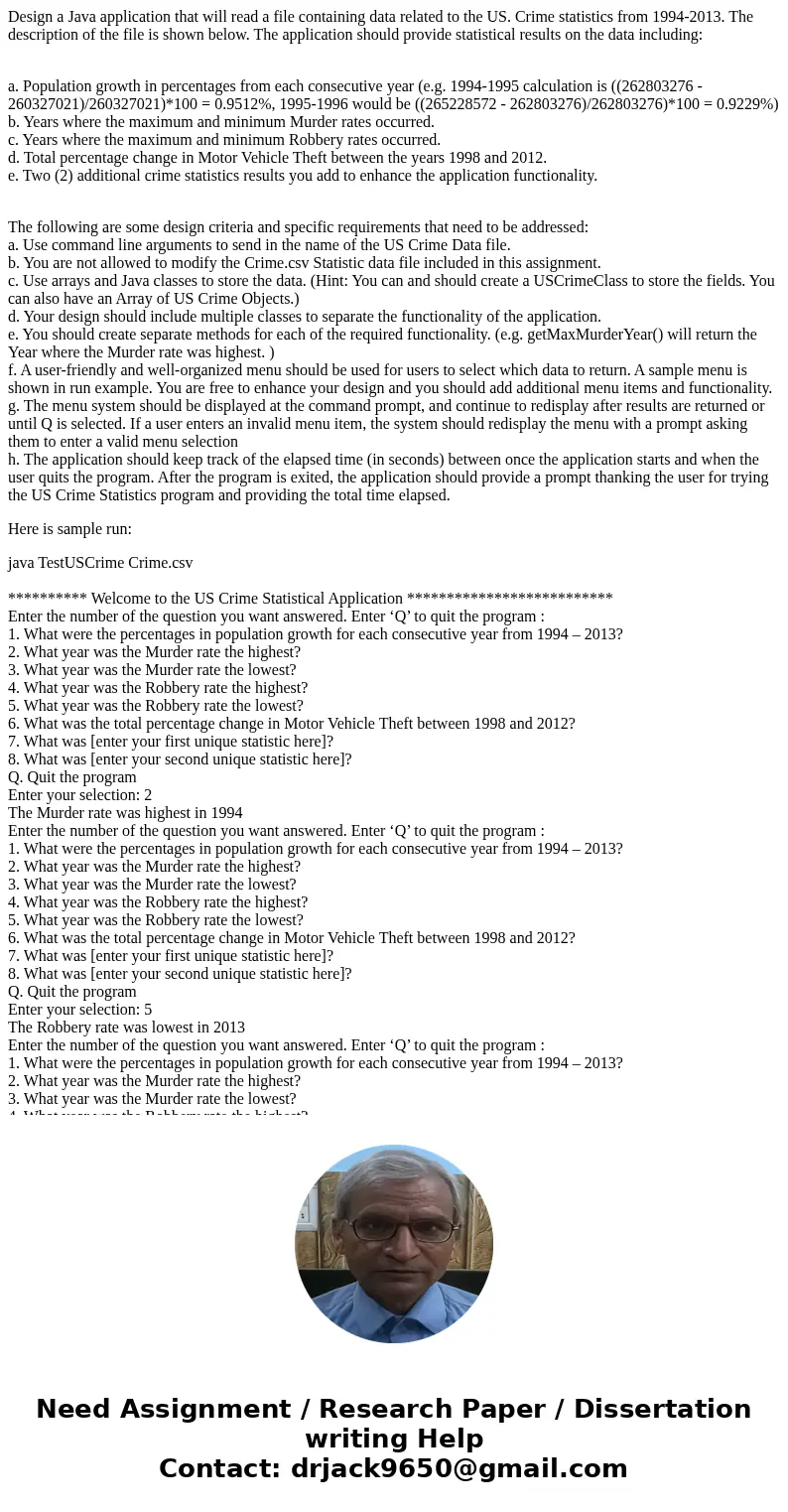
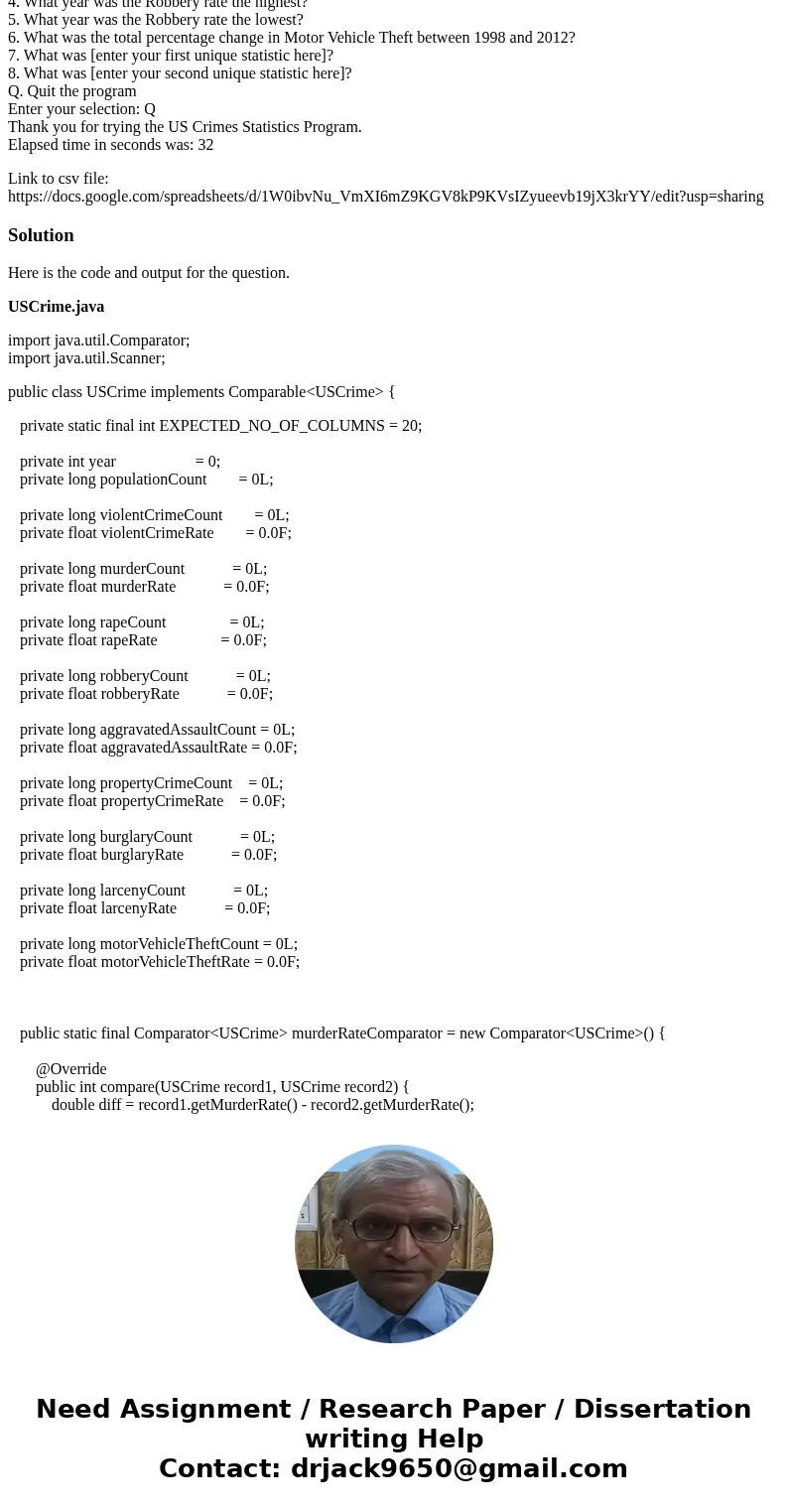
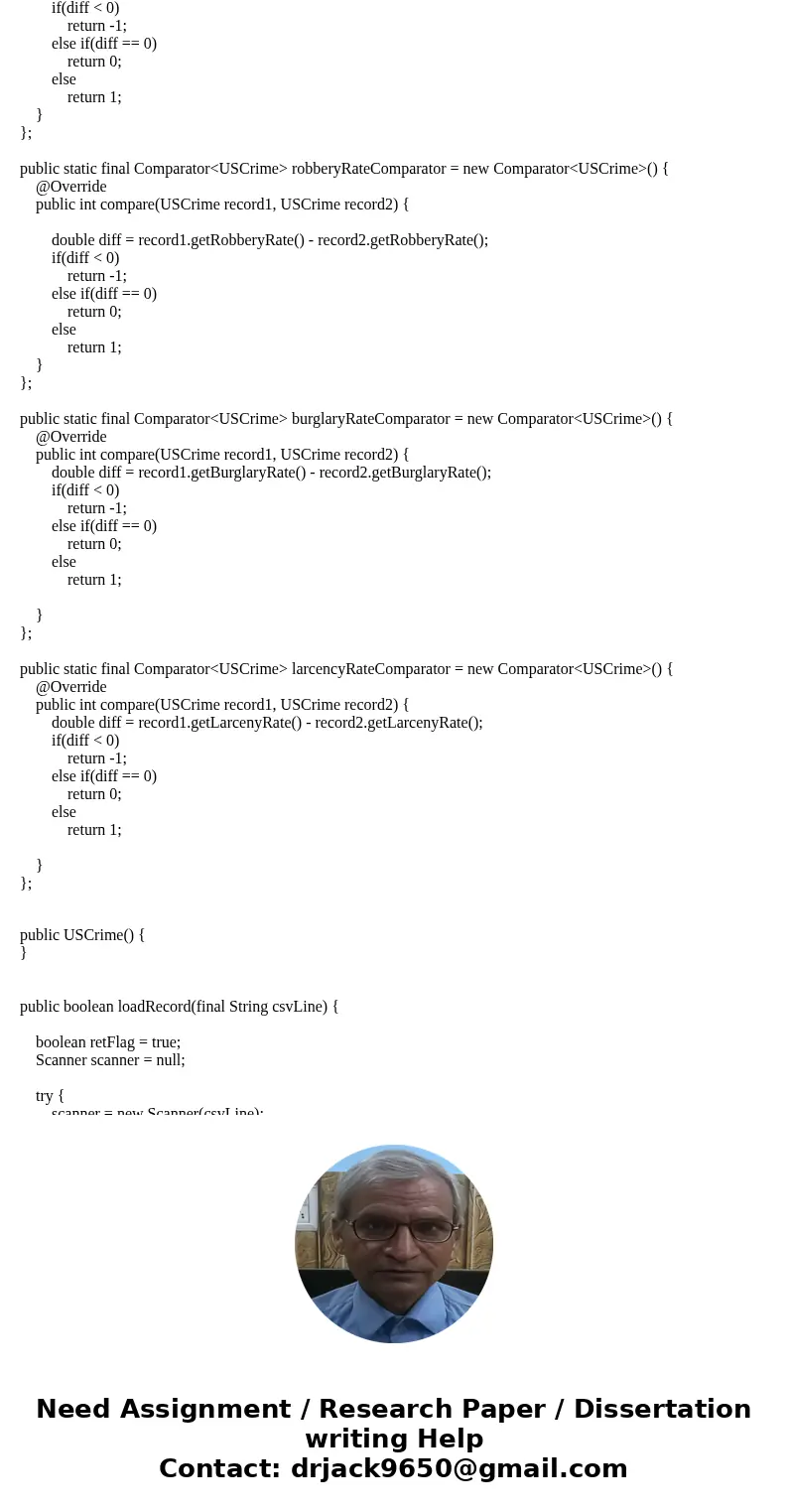
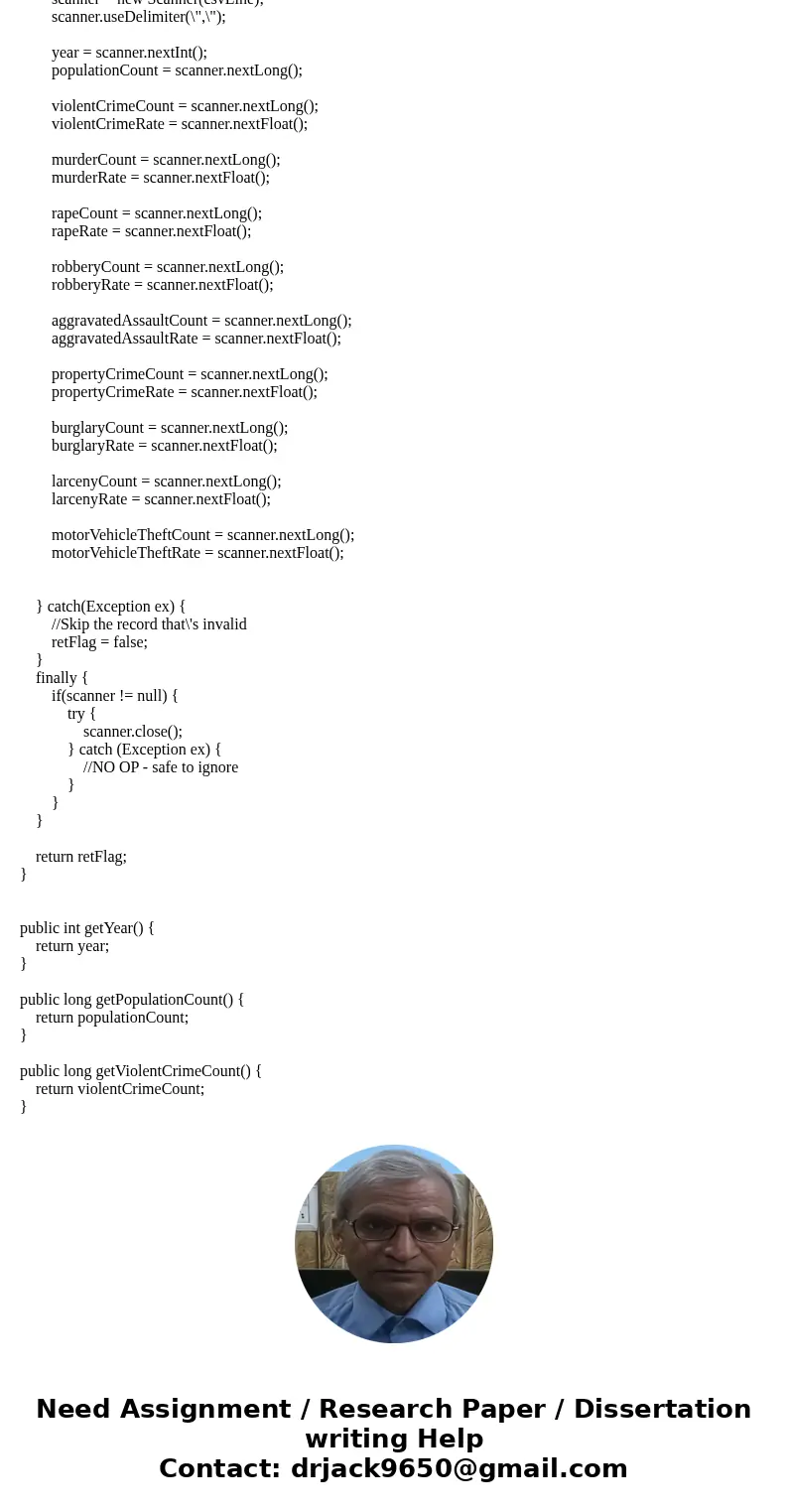
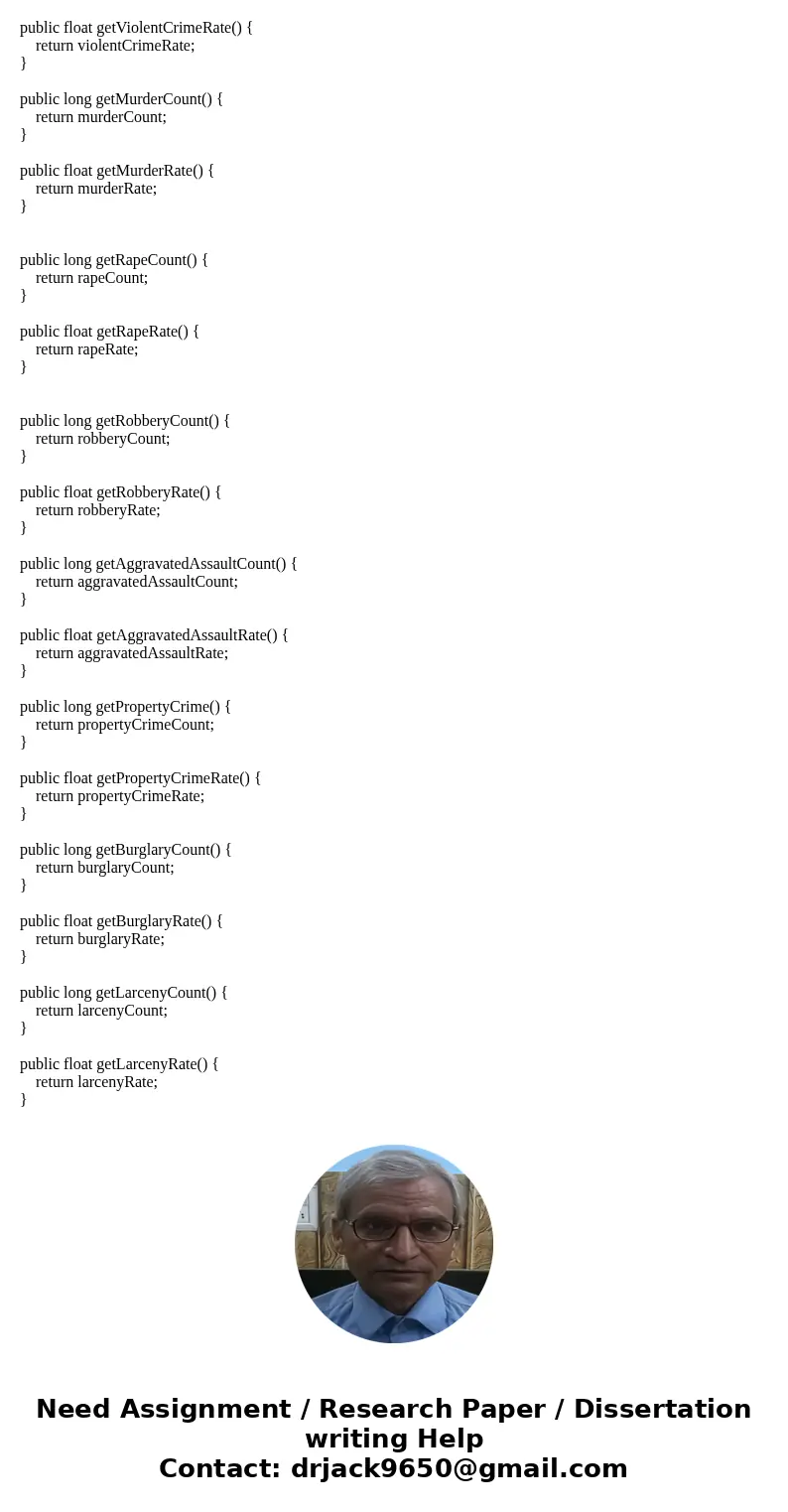
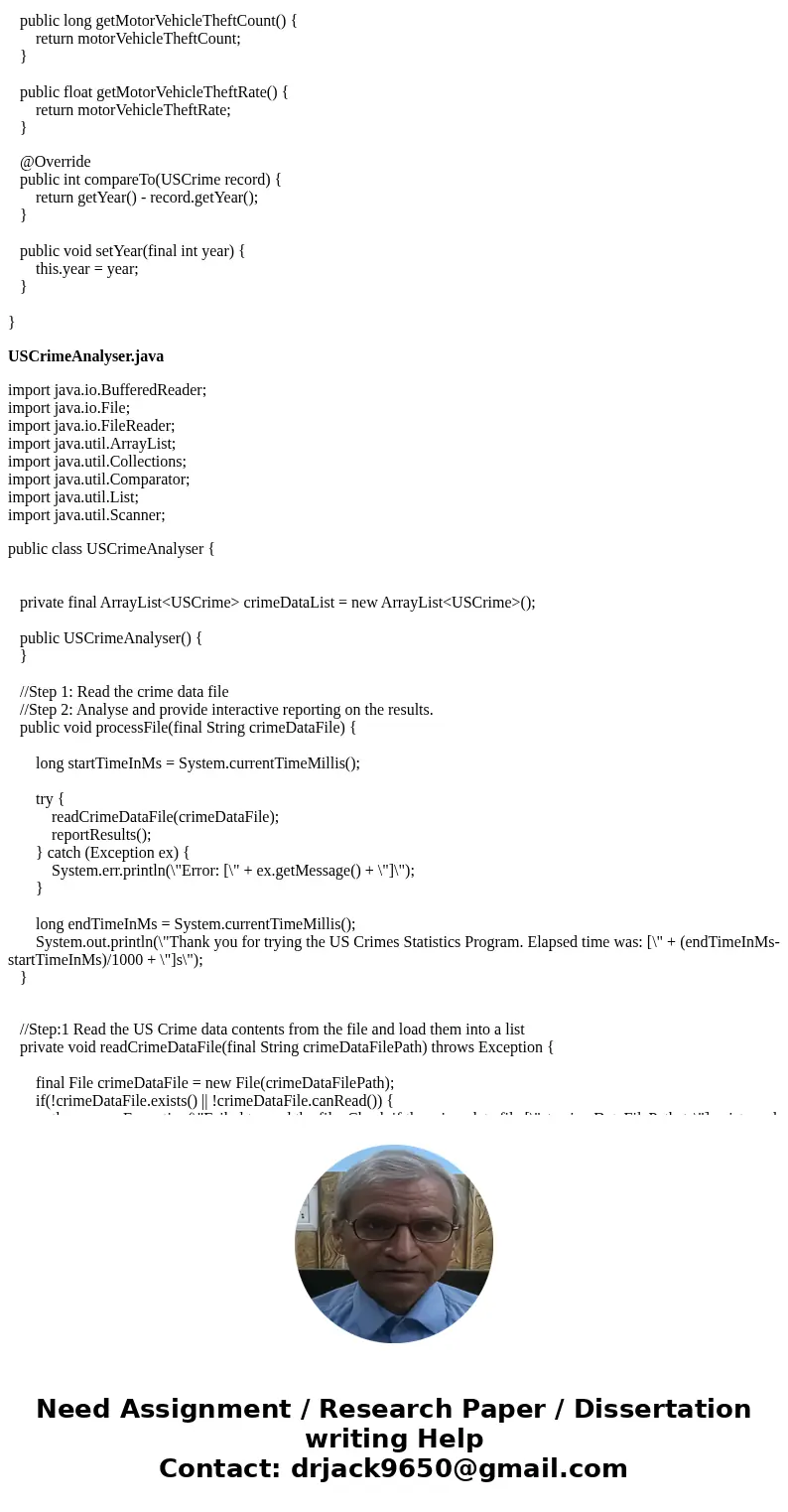
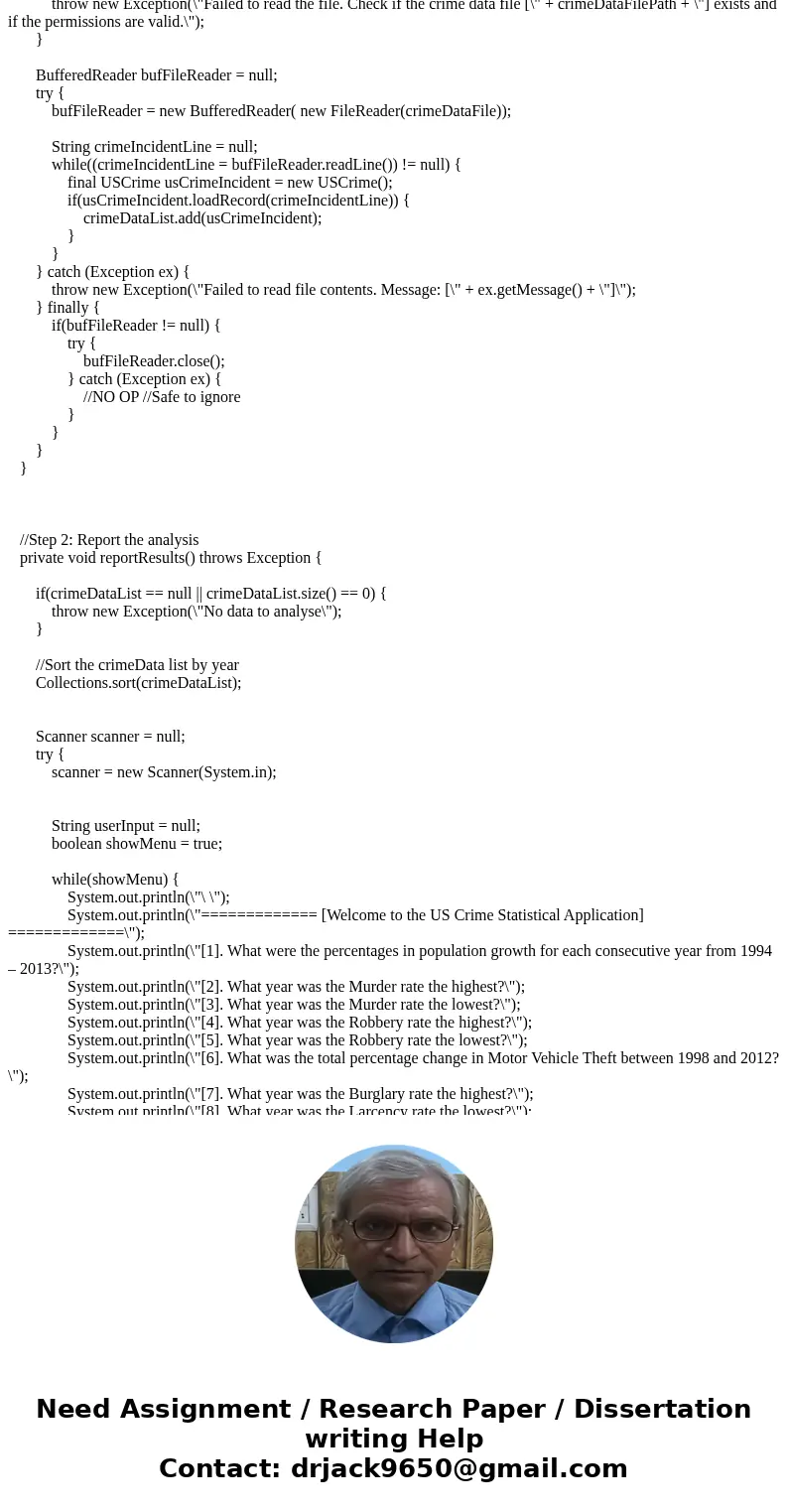
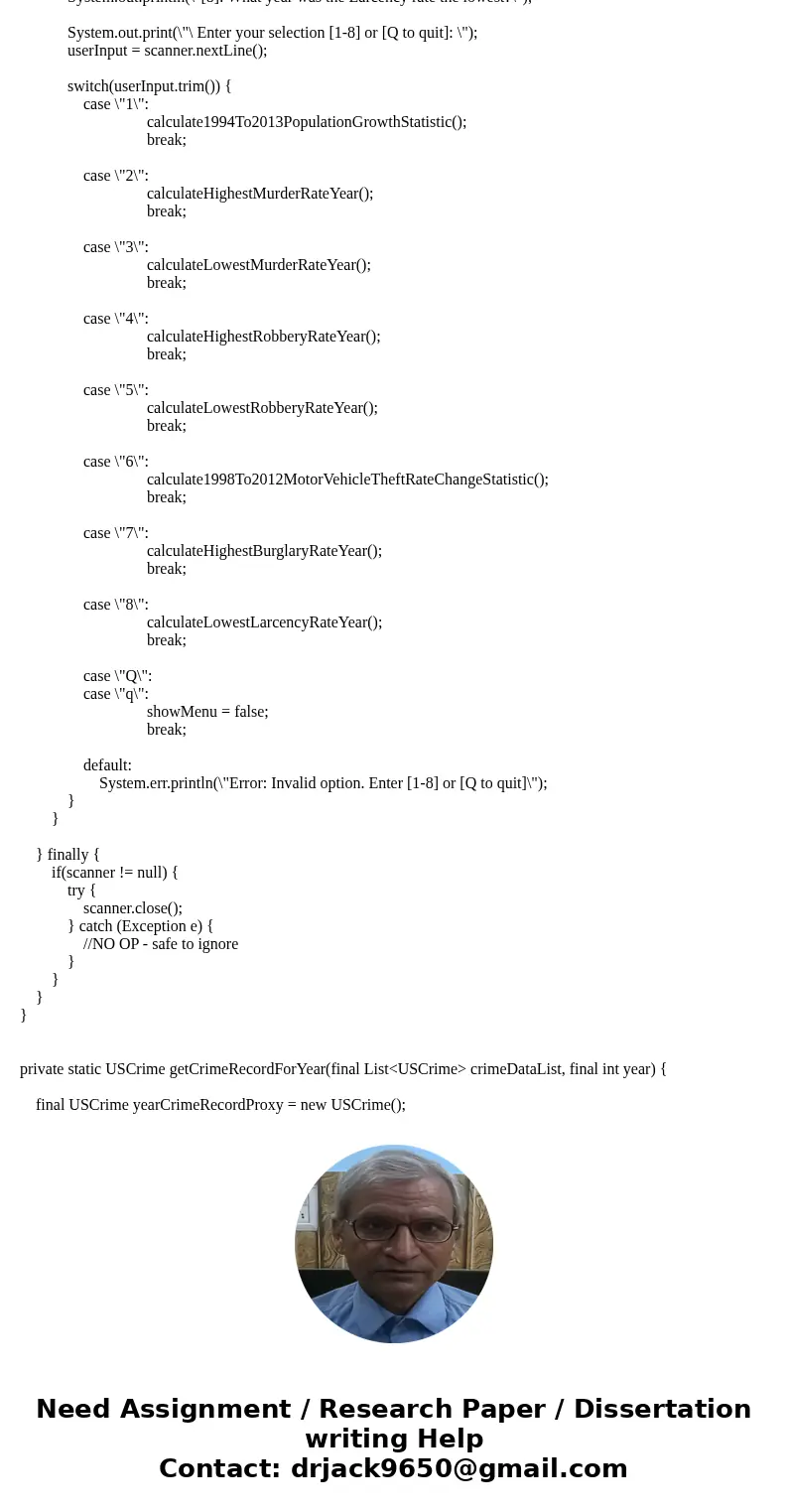
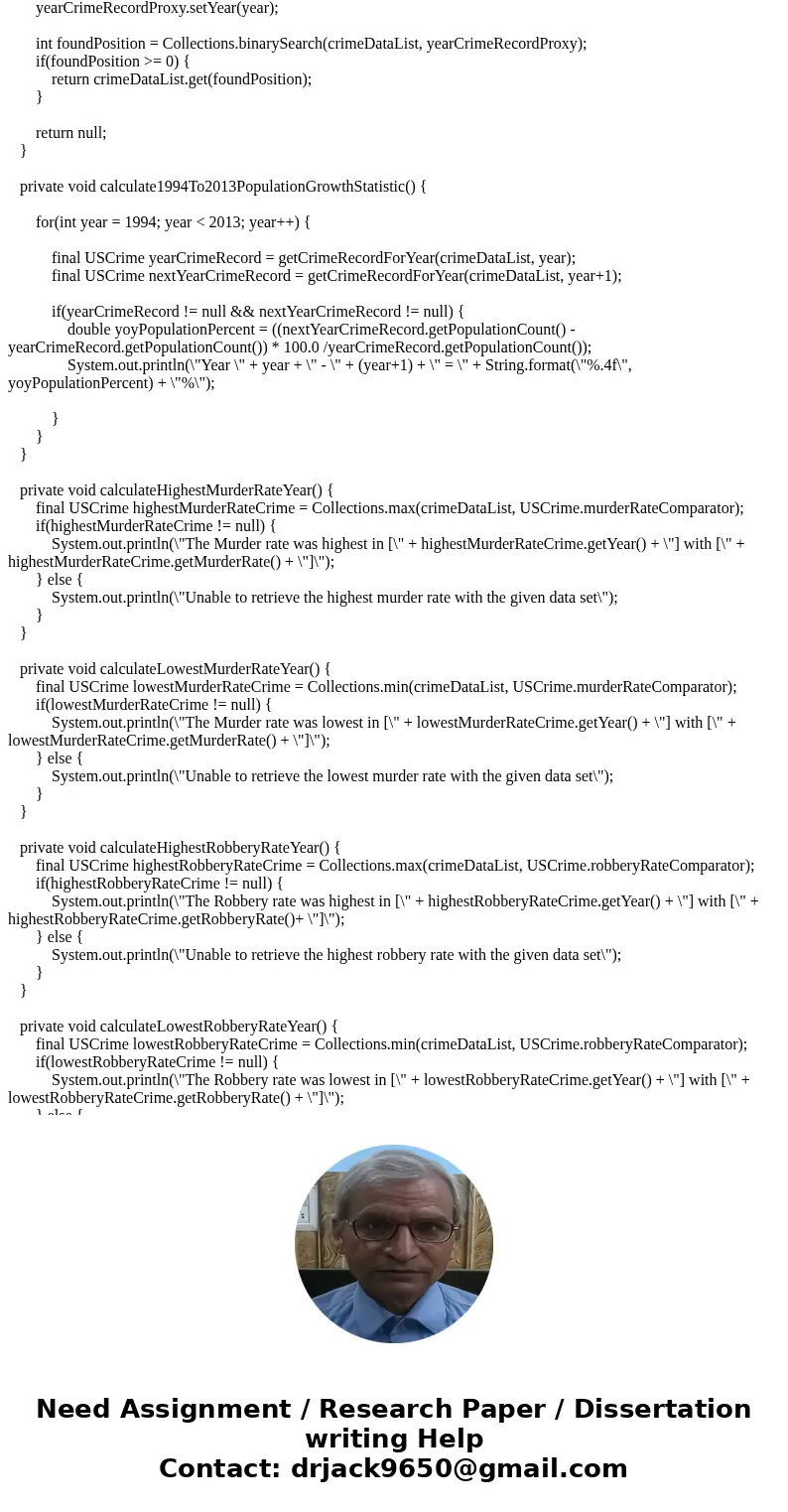
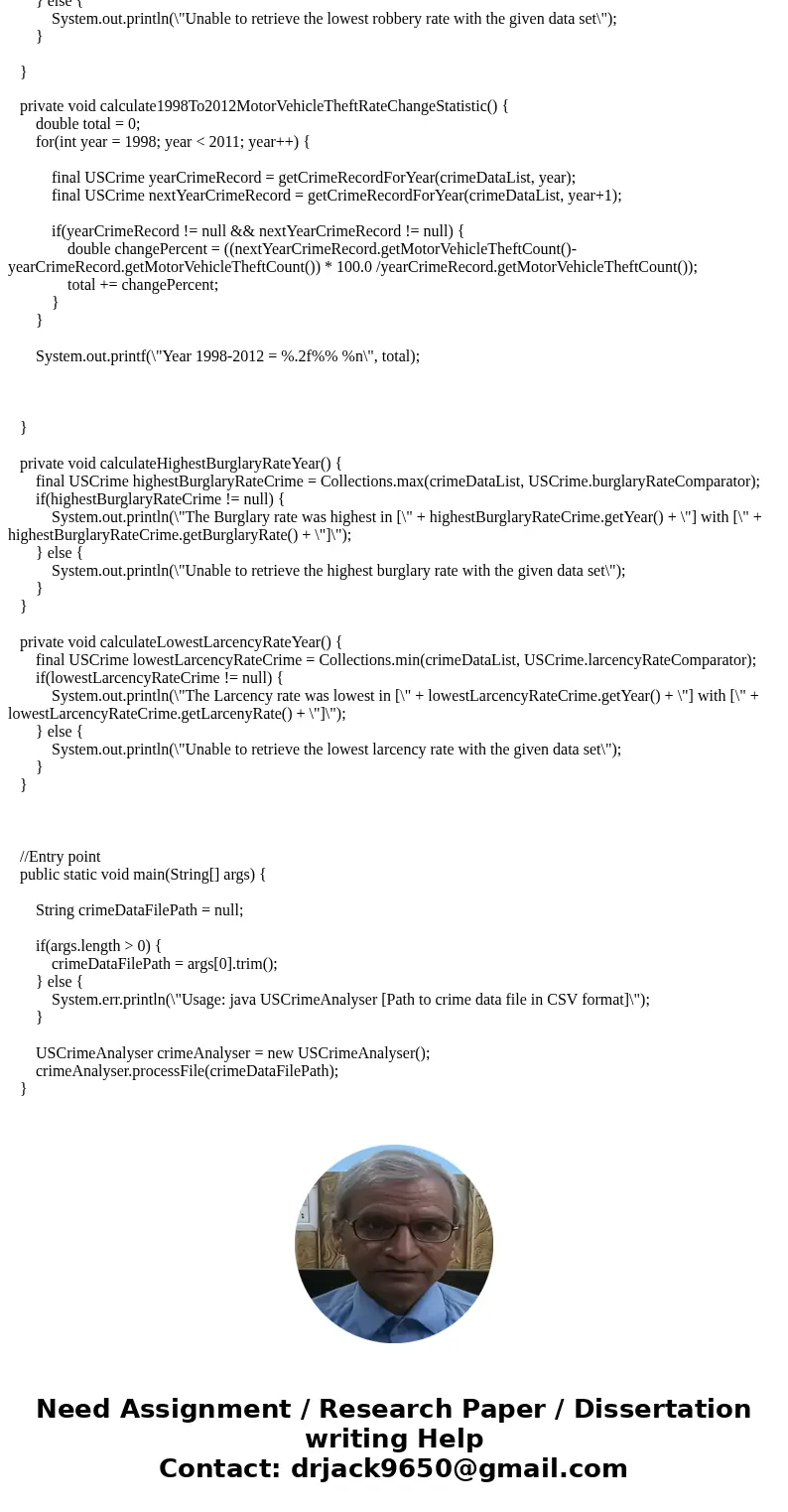
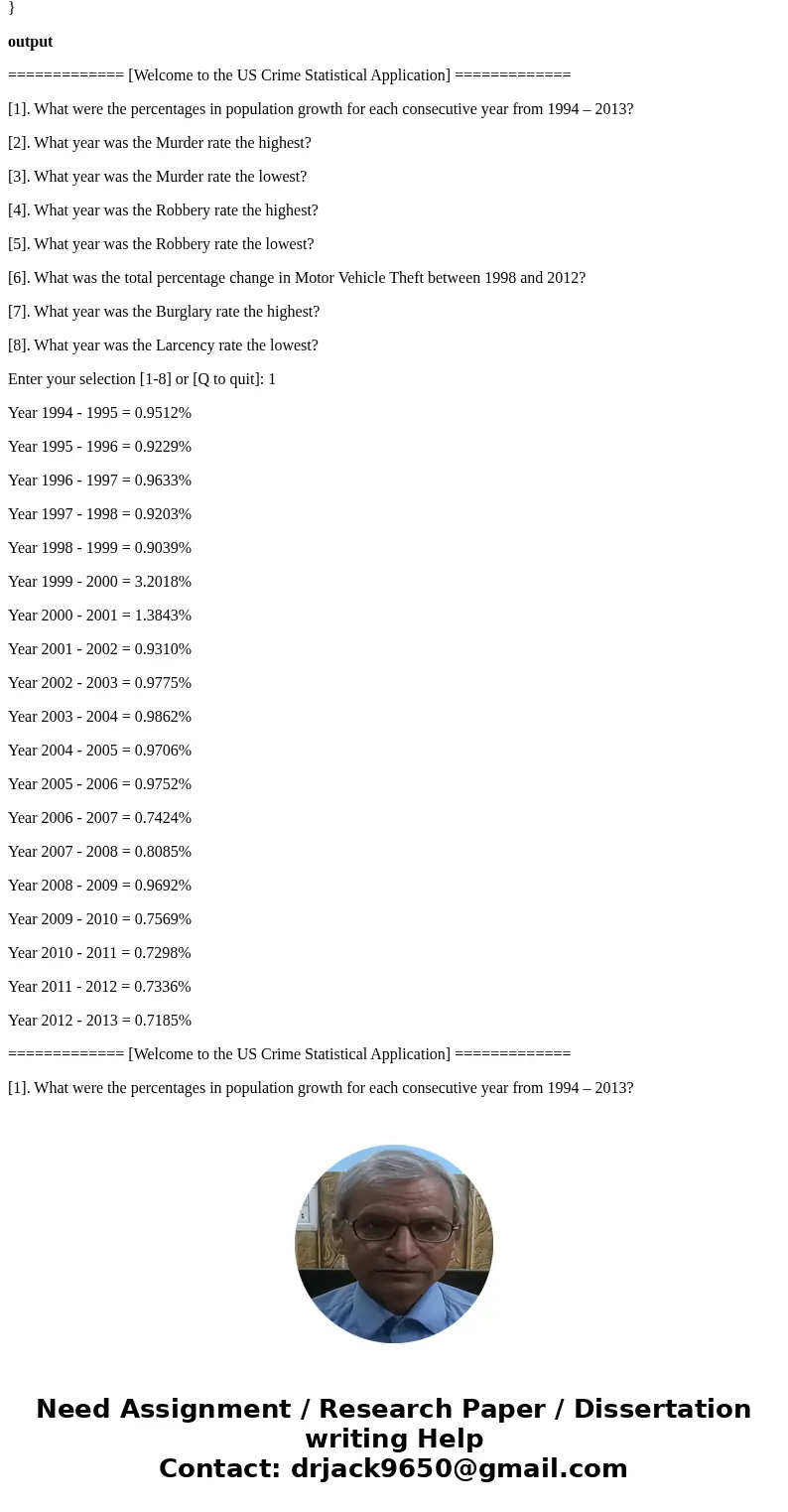
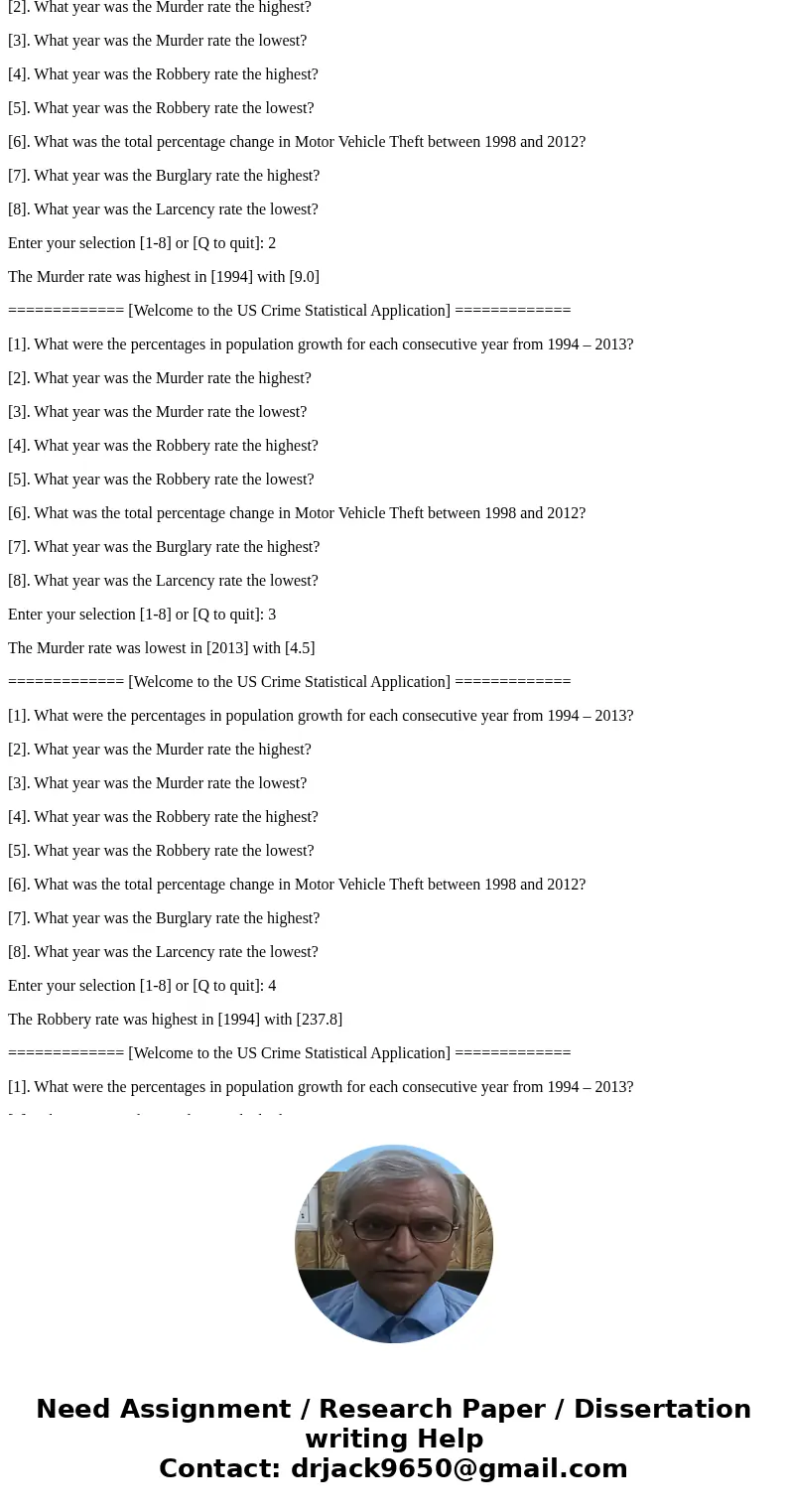
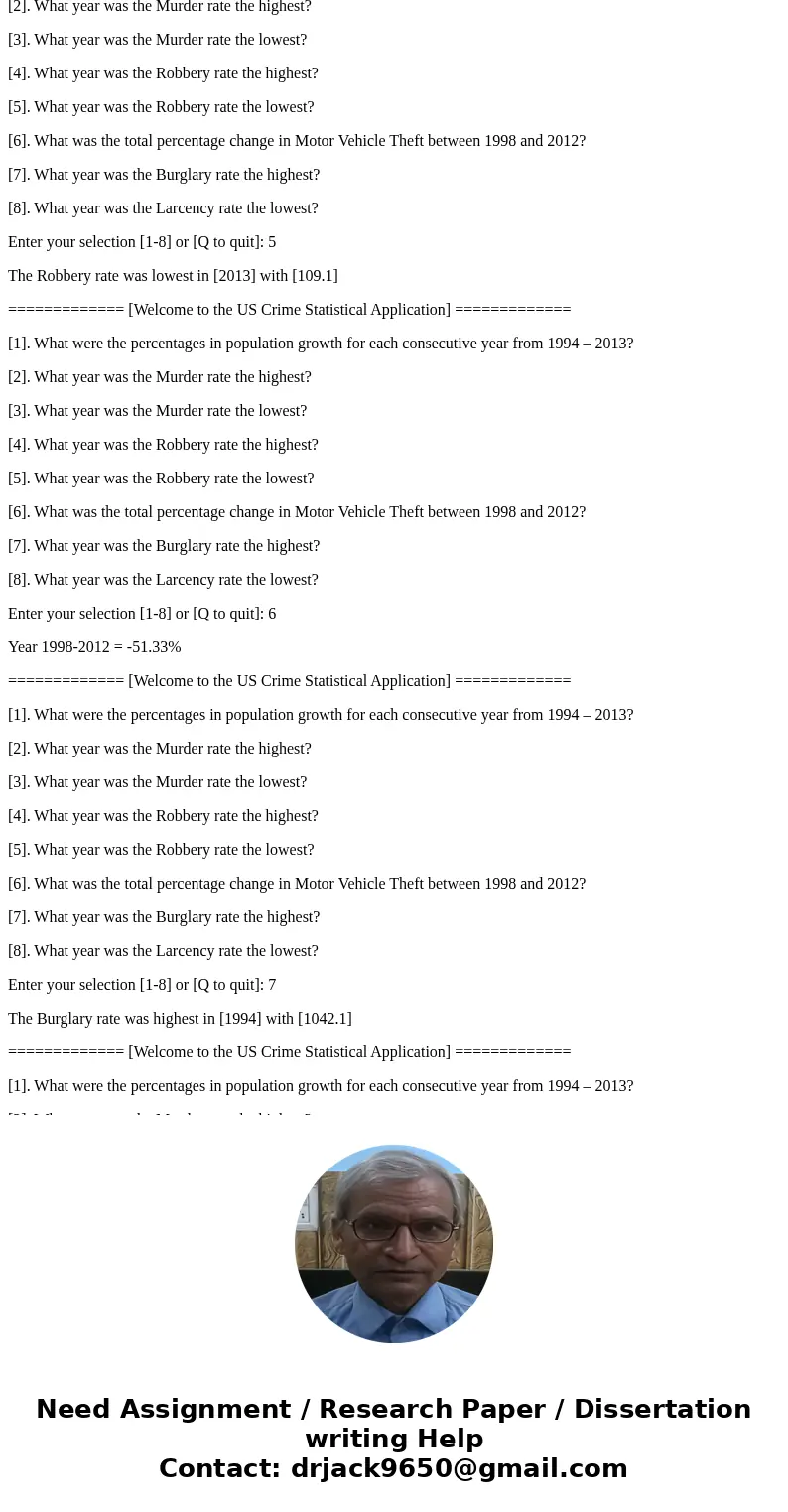
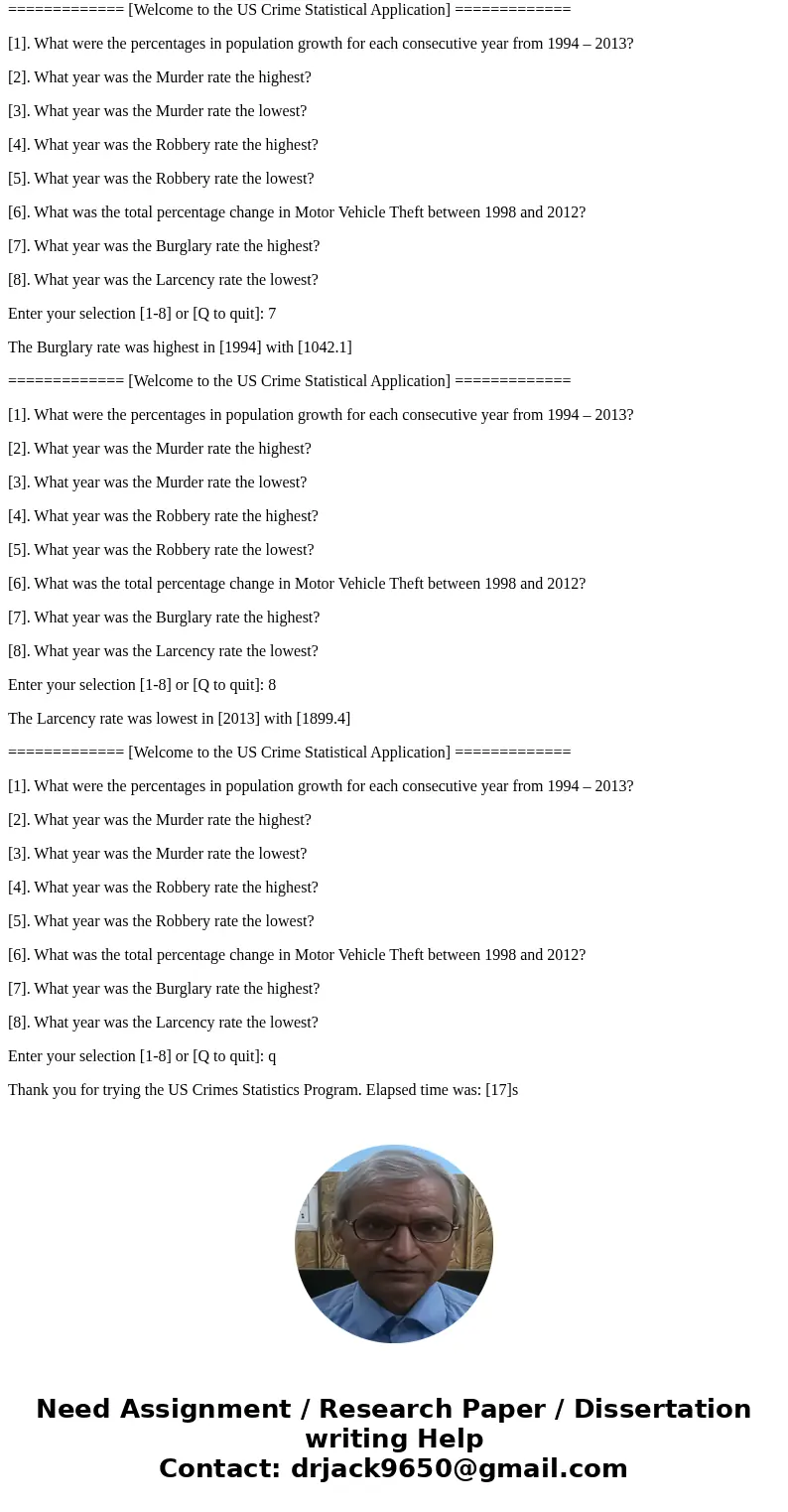
 Homework Sourse
Homework Sourse